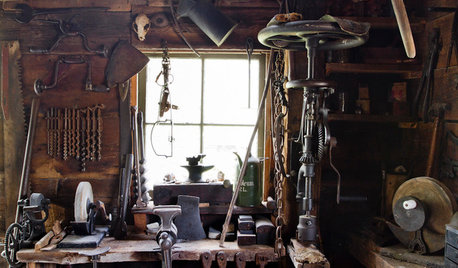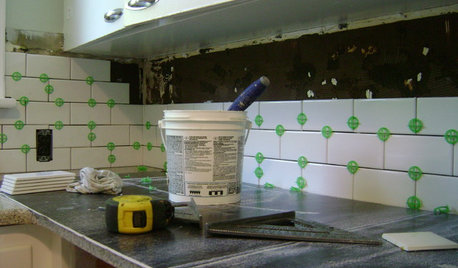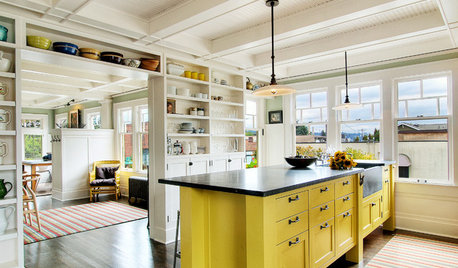Some thooughts about Soil Block Makers
anney
16 years ago
Featured Answer
Sort by:Oldest
Comments (22)
oldpea
16 years agoRelated Discussions
soil block makers
Comments (5)They are pricey I agree and they can reduce transplant shock. But I have found that they also dry out very fast because of the increased surface air exposure and so require more careful monitoring or you will get markedly reduced germination rates. Learned that the hard way. ;) It can be a bit difficult to get your soilless mix just right so that the block retains its shape but isn't too hard for root penetration. Once you do making the blocks goes quickly. You'll need some sort of containment trays to hold the blocks until ready to transplant them to larger containers. Hope this helps. Dave...See MoreSoil Blocks - Excessive Root Growth
Comments (8)So far, so good. I made about 100 2" blocks using Johnny's 4-block maker and their 512 Mix, with a little organic fertilizer mixed in (that might not be necessary). They're on capillary mats wrapped around two layers of plastic eggcrate inside trays with humidity domes. I've sown cukes, squash, melons, basil, and sunflowers, all of which I plan to plant out in about two months. Trays and accessories are from Indoor Gardening Supplies. When the blocks come out of the maker, they're very close together. I expelled the blocks onto a plastic surface and then moved them from there into the flat, spacing them at about ½", to discourage the roots from growing into neighboring blocks. I had no problem lifting and moving them by hand. Some of the blocks have small cracks or have lost corners, and it takes a little practice to fill the mold and push out the blocks without compressing them. But overall they seem pretty uniform. Supposedly soon after germination the roots hold the blocks together and then they're not at all fragile. I'll post again in a few weeks!...See MoreSoil Bock Maker
Comments (25)Just saw this message today after potting up about 100 seedlings from 1/2 inch soil blocks to 2 inch blocks. I just started using soil blocks this year after trying peat pots and peat pellets in previous years. After this exercise I will never go back to anything else! Soil blocks are fun, easy to make and germination happens really fast. My basil germinated in around 24 hours and tomatoes in 48 hours. Hot peppers that are supposed to be hard to germinate have near perfect germination in less than a week. I use a very simple recipe for my blocks: lots of sphagnum peat moss, a handful of perlite, some bone meal, some greensand and some wood ash( to reduce the peat moss acidity). Nothing is precise and everything is just thrown in. I mix this up well and add plenty of water and let it soak for several hours. The consistency should be that of slurry or thick oatmeal. This is a LOT more water than if you watered your plants directly but this is what gives the blocks consistency. Always water the blocks from below or use capillary mats. After a while the blocks harden with the fibrous roots in them and become nearly indestructible. You can actually drop them on the floor and they dont even break! Check out the attached links for pictures of coleus, peppers, basil, different varieties of tomatoes and asian eggplants growing in soil blocks. Here is a link that might be useful: Soil Blocks...See MoreAny experience with the soil block makers
Comments (1)Here is a discussion about them from last week that should help. (linked below) And Here is a list of previous discussions on them. Dave Here is a link that might be useful: Soil Block makers...See Moresoonergrandmom
16 years agoweirdtrev
16 years agoanney
16 years agoanney
16 years agokkfromnj
16 years agonygardener
16 years agocambse
16 years agoanney
16 years agoanney
16 years agooldpea
16 years agoanney
16 years agocambse
16 years agonygardener
16 years agoesobofh
16 years agoesobofh
16 years agocambse
16 years agonygardener
16 years agocambse
16 years agopottingblockguru
15 years agowally_1936
15 years ago
Related Stories

GARDENING GUIDESThe Poop Scoop: Enrich Your Soil With Good Old Manure
Get over the ick factor already — this natural super-ingredient for soil has so many benefits, you'll wonder why you ever went chemical
Full Story
GARDENING GUIDESHouzz TV: Make a Worm Bin for Rich Soil and Happy Plants
A worm-powered compost bin that can fit under a sink turns food scraps into a powerful amendment for your garden. Here’s how to make one
Full Story
MATERIALSAre You a Maker? Show Us Your Favorite Tool or Material
Houzz Call: A tool or material can be a maker’s best friend. We’d like to see your favorite — and what it helps you achieve
Full Story
DECORATING GUIDESMood Makers: 5 Easy Ways to Put Your Home On Trend
You don't need a full renovation to modernize outdated interiors. These tips can help your home feel fresh and current without a ton of work
Full Story
DECORATING GUIDESMood Makers: Small Rooms, Spacious Feel
Make a small room feel more open with these decorator tricks for visually expanding the space
Full Story
EVENTSMaker Faire: The Future Is Now
Kid-friendly robots and high-tech sprinkling systems: This fair shows what’s new and next
Full Story
WORKING WITH PROSWhat Do Landscape Architects Do?
There are many misconceptions about what landscape architects do. Learn what they bring to a project
Full Story
ARCHITECTURE4 Things a Hurricane Teaches You About Good Design
When the power goes out, a home's design can be as important as packaged food and a hand-crank radio. See how from a firsthand account
Full Story
MOST POPULAR19 Kitchen Projects Every Homeowner Should Know About
Could your kitchen use a new sink, a backsplash, updated hardware, better organization, a good cleaning? Here's how to get started
Full Story
KITCHEN DESIGNHow to Lose Some of Your Upper Kitchen Cabinets
Lovely views, display-worthy objects and dramatic backsplashes are just some of the reasons to consider getting out the sledgehammer
Full Story





cambse